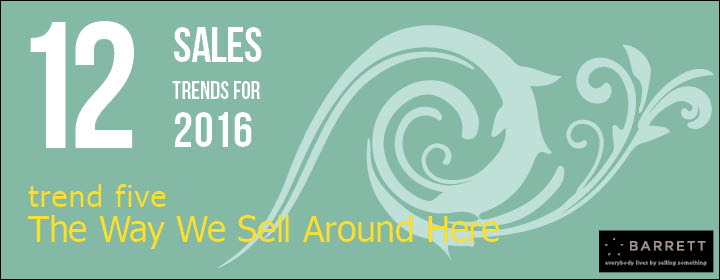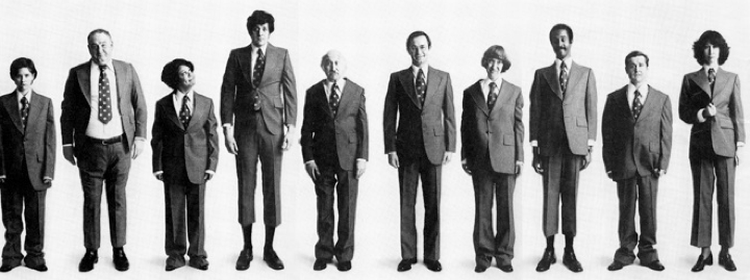
Sales Trend 5 from the Barrett 12 Sales Trends for 2016 Report is ‘The way we sell around here’.
The Sales Dream – A low cost, high performing sales force that delivers more sales at better margins to increasingly loyal customers. Sounds like some utopian vision. Not necessarily.
This sales trend highlights the best practices being adopted by smart companies who are focused on embedding ‘How We Sell Around Here’ as their minimum standard of sales excellence and how they are reaping the rewards of their continuous learning programmes and sound sales strategies. They know that if any business wants better sales results one of the first things they must do is define a robust sales strategy and map the right sales processes that will deliver the sales strategy planned for, then consistently train and coach their salespeople to a minimum standard of excellence commensurate with that sales process.
We cannot approach something as significant as ‘How We Sell Around Here’ in a piecemeal manner which, sadly, has been the default setting for many a sales teams and businesses for years. Believe it or not many businesses and sales leaders are still looking for an ‘event’ style approach that will transform their sales team into sales superstars for as little time and money as possible. Smart companies know better.
They know the conundrum has always been how to develop salespeople to a minimum standard of excellence and ensure that investment in strategy, process improvement, training and other support activities provides not only an attractive return, but more importantly, produces sustainable results in the form of incremental sales.
Smart companies know that sales training delivers little by way of sustainable sales results unless it is targeted to the specific sales knowledge and skills required and is part of enterprise-wide commitment. They know that sales training without a blended learning approach that offers structured, continued “on-the-job” training and coaching does not work.
Whether sales processes need to be created or existing sales standards need to be reviewed and overhauled, this trend points to smart companies making sure their sales processes are specific and meaningful and reflect the reality of their sales operations and the go-to-market sales strategies. Smart companies are investing in blended learning environments which in this context means content and learning resources that are available to everyone at any time. For instance, online training today makes this a very easy task to tick off the to-do list. Combine this continuous blended learning approach with a sales leadership team that is well trained and capable of providing coaching and support in an ongoing fashion and you have the makings of ‘How We Sell Around Here’. Smart companies know that such a continuous learning culture does not require huge efforts but requires a constant trickle of input and stimulation – they know that sales leaders don’t have to coach all the time but they can coach at any time.
Research, here and overseas, has shown that having a consistent sales process salespeople can be trained and coached in, can apply and be held accountable to, will help improve sales results by around 20%. It establishes a reliable and consistent quality buying experience for our clients, creates trust in the relationship not only with their preferred client representative, but also trust in the organisation to consistently provide a high quality level of support and advice. Having a consistent sales process, resources and methodology enables sales managers to better recruit, induct, train, coach, and manage their sales teams in ‘How We Sell Around Here’. It provides orientation and guidelines for both, sales managers and their teams.
To embed a ‘How We Sell Around Here’ culture smart companies make sure the following details are in place and communicated across the sales force:
- Clear and unambiguous sales strategy and go-to-market action plans for relevant market segments
- Clear sales mission that outlines the purpose, strategy, standards and values we need to define and deliver ‘how we sell around here’
- Strategic alignment of the sales operation, specifically designed to reduce the cost of sale and support incremental sales productivity
- Sales training that is adapted to meet the conditions of your unique sales operations, market and products
- Sales training that offers a continuous blended learning framework over extended periods of time delivering a combination of online learning resources, infield work, practical activities i.e. role plays, case studies, presentations, applied classroom work*, as well as regular sales coaching, mentoring and sales management support programmes that provide post training reinforcement and help ensure sustainable use of sales skills and techniques learned
- Market Segmentation, competitive profiling and the creation of effective sales strategies that position and differentiate your company highlighting your competitive advantage
- A sales oriented version of the Balanced Scorecard, created to measure salespeople and sales performance
One Size Does Not Fit All
In today’s markets there is no such thing as “off the shelf solutions”. Every sales operation is distinctly unique and demands an approach and solution that is built around the challenges it faces, rather than offering a canned solution and training that provides generic alternatives.
That is why defining ‘How We Sell Around Here’ is critical for success in sales today.
*Effective classroom training has moved to an applied model where participants can put into practice the theory, processes, knowledge and skills needed in their roles. Participants are now being asked to do their theory learning outside of the classroom by completing online modules, reading articles, and so on to come prepared to apply what they have learned in the classroom. This is known as Flipped Learning which is a pedagogical approach in which direct instruction moves from the group learning space to the individual learning space, and the resulting group space is transformed into a dynamic, interactive learning environment where the educator guides students as they apply concepts and engage creatively in the subject matter.
Image credit: “One size does not fit all” taken from an old Xerox Advertising.



New Article Email Notification